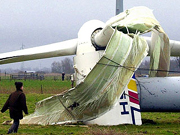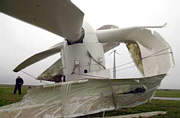
|
||||
Wind Energy companies are counting on naive residents Wind Energy companies will try to convince you that
Reality check: The Indiantown project would be Illinois Wind Energy's FIRST project. Even though ILWE is partnered with other corporations, it is important to note that ILWE is a LIMITED LIABILITY company, meaning that its partners are shielded from damages or reparations if ILWE cannot pay. Currently, ILWE isn't even operating legally in the City of Chicago, as it does not have a legitimate business license.
Florida Power & Light is one of the largest Wind Energy companies in the U.S., comparable in size to Enron before Enron's collapse. FPL has not made friends in many of the communities it has targeted, as evidenced in Addison, Wis., where residents lobbied to prevent FPL construction, citing a campaign of misinformation by FPL and backdoor politicking. www.jsonline.com/news/ozwash/aug01/addison24082301a.asp
Reality check: Wind turbines pose threats to human and animal welfare. Recently constructed turbines in Eifel, Germany, could not withstand the first windstorm of 2002 and crumpled. These turbines are about as tall as a football field and weigh as much as a DC 9 or Boeing 737. Ice throw from the turbine blades is a serious condition in northern climates. Lumps up to 2 pounds can form and could be thrown nearly 1,500 feet, which is farther than most 750-foot property setbacks.
Wind turbines and their ancillary equipment have killed raptors, such as hawks and eagles, and other migrating birds. Windfarms have produced enough bird collisions and deaths to raise concern from wildlife agencies and conservation groups.
Reality check: Learn lessons from Enron. "Enron, for instance, managed to pick up several near-bankrupt wind and solar power companies over the years and treated them like political lottery tickets. Wherever Enron went, pious campaigns for the virtues of renewable energy subsidies (in effect, subsidies for Enron) were sure to follow." -- Wall Street Journal, Jan. 21, 2002. Now Enron wind farms lay scattered across the country, and Enron is asking a federal agency to pay a huge insurance claim on an idled power plant. Enron is not the only Wind Energy provider to go bankrupt. Kenetech, the market leader in the U.S., declared bankruptcy in the spring of 1996. Now communities that were assured funds to dismantle turbines at the end of their life spans are uncertain of their future.
Reality check: Residents do not move into a community to become wind farmers. Residents move out to get away from the turbines. After construction of turbines in Lincoln Township, Wis., four families' homes were bought out and raised by the Wind Energy companies, reducing the tax base. One 175-head dairy farmer is considering leaving the family business after raising generations of prize-winning cattle. In addition, the market for potential buyers of homes adjacent to the wind turbines has been reduced by 50 percent, according to a township study. As for jobs, construction contracts last only a few months and the contracts for a few dozen workers will benefit mostly non-local companies.
Reality check: The wind farmers do not get to use electricity from the wind turbines. The local residents don't either. This electricity is headed to Chicago. Because of a mandate by Mayor Daley, the city government facilities must purchase electricity from power companies with 20 percent renewable energy sources. Chicago's Commonwealth Edison is the most likely buyer for Indiantown's wind energy. Take a look at the real benefactors of downstate Wind Energy projects. Wind might be free but harnessing it is not. Wind only seems to be the cheapest form of energy in the U.S. because of heavy subsidies. When you add in the cost to the taxpayers, wind costs more than fossil fuels and hydroelectric power. Moreover, Wind Energy companies have been holding their breath over subsidies that recently expired. "If the tax credits are not extended, the boom both in California and in the Midwest likely will collapse." -- Independent Energy, April, 1999 According to a report by the National Center for Policy Analysis, "A conservative estimate of the total U.S. taxpayer subsidy to wind power is more than $1,200 per installed kilowatt."
Reality check: When unreliable winds cannot produce the required amount of electricity, a equivalent backup source that can produce firm power is required, such as oil, gas, coal, or nuclear. Extracting one kilowatt/hour of energy from the wind costs four times as much as using fossil fuels.
Reality check: The wind resources are rated from 1 to 7, with 7 being the best, based on average wind speeds. A Level 3 wind resource is generally accepted as the minimum required to make a windfarm economical. According to the Renewable Resource Data Center, the average for the area is actually Level 2.
Reality check: Once the turbines are constructed the power companies do not have to address problems in the communities if remediation is not specified in their usage permits. The "good neighbor" public relations campaign by Wisconsin Public Service included ¤ Razing the homes of residents who complained of noise (giving them a 30-day take-it-or-leave-it buy-out deal) ¤ Ignoring the complaints of a dairy farmer, who has traced the decline of milk production and increase of cancer and deformities in his formerly award-winning herd to stray voltage/electrical pollution from the power lines associated with the turbines. Other causes of concern are the headaches, nose bleeds, rashes, night sweats and chronic diarrhea suffered by his family and sometimes by visitors to the farm. (WPS did not increase the number of power lines in the area even thought the amount of current increased.) ¤ Recording noise complaints via a phone hot line (that has never lead to any action on reducing the noise) ¤ Setting up a noise study that measured decibel levels only three days per season (because WPS said they didn't have the funds for a more complete study) ¤ Giving in to construction of TV towers for residents with interrupted reception (only after continued pressure from residents) According to a report by NCPA, problems with Wind Energy are not minor, even to wind power's leading proponents. Paul Gipe, author of "Wind Power for Home & Business" and "Wind Energy Comes of Age," in an October 15, 1996, letter to the chairman of the California Energy Commission, called for a moratorium on new wind subsidies until the problems of previous construction were addressed. Stated Gipe: I am a longtime advocate of wind energy in California and my record in support of the industry is well known. I have chronicled the growth of California's wind industry for more than 12 years. It therefore pains me greatly to urge the Commission to ... recommend to the legislature that no funds from the [California Competition Transition Charge] be distributed to existing or future wind projects in the state. Funds that were destined for this purpose should instead be deposited in a wind energy cleanup fund to be administered by the Commission. Money from this fund could then be used to control erosion from plants in California, to remove abandoned and nonoperating wind turbines littering our scenic hillsides, and to mitigate other environmental impacts from the state's wind industry.
Reality check: The wind turbines affect human and animals in profound ways. "For people living nearby, wind power plants are an incessant strain on their vegetative nervous system. Reflections of light and shades, permanent noise, intermittent sound, and inaudible low-frequency vibrations cause mental as well as physical complaints or illnesses. In this way, the basic right to physical and mental well-being is violated. Citizens for whom the emotional stress with its physical effects gets unbearable are threatened with expulsion from home." -- Resolution of the Citizens' Action Committees against Wind Turbines in Germany Not even environmentalists can fully support the wind farms because of their slaughter of golden eagles, American kestrels, red-tailed hawks, and other birds. According to the National Audubon Society, "more eagles are killed by wind turbines than were lost in the disastrous Exxon VALDEZ oil spill." Questions also are being raised about concerns over erosion from service roads, flashing lights and red-and-white paint required by the FAA on tall towers, rushed construction for tax considerations, fencing requirements, oil leakage, and abandoned turbines. "Unfortunately, there are hundreds, if not thousands, of wind turbines in California that are less reliable, less well maintained, and less well sited. . . . Some simply do not work." -- "Wind Energy Comes of Age" Read more about turbines endangering lives. For more information e-mail info@windpowercons.com
noise log | more resources | scenic photos | eyesore photos | ||||

